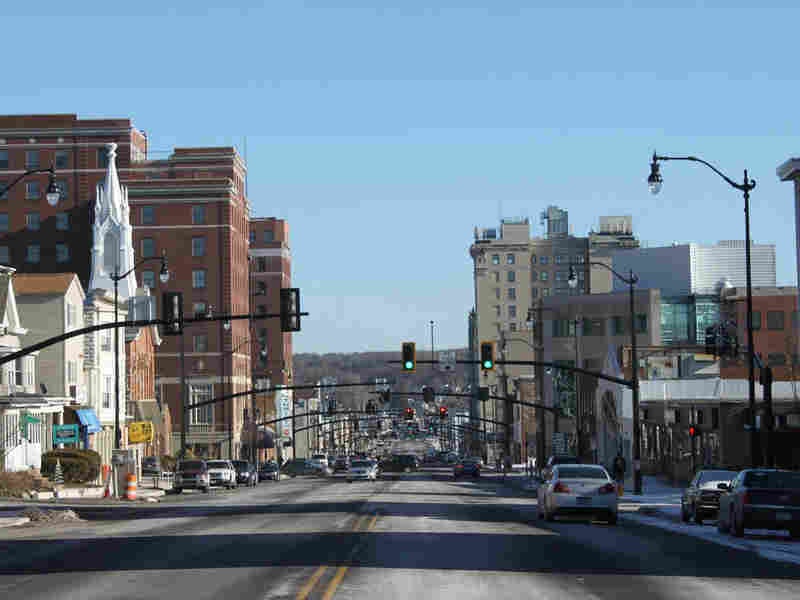Report: The past decade has been rough for Pennsylvania cities

Krista Schneider/Courtesy of Downtown Hazleton Alliance for Progress
Income and housing values dropped as the poverty rate and food stamp use increased in most Pennsylvania cities, according to a recent report.
Teri Ooms, executive director of The Institute for Public Policy & Economic Development at Wilkes University, is trying to understand the trends. “Maybe it’s just the natural forces of this recession (having been) so long and so deep,” she said.
The Penn State Data Center report analyzes U.S. Census Bureau data collected from 2010-2014, and compared them to the 2005-2009 period.
The most dramatic changes identified in the report happened in the types of communities Ooms says are most vulnerable to wider economic shifts: small population and less-diversified, already-struggling economies.
“Major cities have such larger populations. Philly, [for example,] would have to lose a number of major employers before you’d see huge losses in jobs,” Ooms said.
Philadelphia’s industrial sector, major universities and hospitals bring major economic stability to the nation’s fifth largest city. It’s not that way in smaller cities. Hazleton residents, for example, lost jobs amid downsizing of major local employers. That included warehousing and distribution centers, which scaled back in response to a nationwide decrease in retail activity, Ooms says.
Ooms says the recession and small-city vulnerability are likely behind the increasing economic struggle in Hazleton suggested by the Census numbers:
Hazleton’s average median household income from 2010-2014 is down 17 percent from 2005-2009
70 percent more residents use food stamps
Nearly 60 percent more residents live below the poverty line
Such vulnerability was seen elsewhere, too.
Income dropped in 13 cities, rose in two and changed negligibly in others examined.
Income dropped most dramatically in Duquesne (38 percent)
Median household income rose in Aliquippa by 13 percent and Jeanette (Westmoreland County) by 20 percent.
The number of people using food stamps nearly doubled in St. Mary’s, as the city lost residents.
It was up 87 percent in Coatesville
Three Act 47 cities saw an increase: Shamokin, Pittsburgh and Reading
52,000 more people used food stamps in Philadelphia
The poverty rate increased in 24 cities, half of them by at least 30 percent.
The number of people living below the poverty line increased by more than 61 percent in New Kensington, to a rate of 23 percent
Duquesne has the highest poverty rate, at 43 percent, followed by Lock Haven at 41 percent and Reading at 35 percent
Housing values were down in 19 cities, up in two and didn’t change significantly elsewhere.
Housing value dropped in Allentown by 18 percent and in Bethlehem by 10 percent, although median owner-occupied home values remain higher than the $165,000 statewide figure.
The Lehigh Valley’s housing market peaked in May 2006, then started dropping and didn’t hit bottom until six years later, says real estate analyst and Lehigh University adjunct professor Loren Keim. The housing market has since started to recover. It’s not back to where it was before the downturn, but including 2015 numbers would have made the decline appear less dramatic, Keim says.
Although both Allentown and Bethlehem have made headlines for revitalization efforts and new businesses, the activity is too recent to affect housing values. Also, the current boom is fueled by tax break programs with long-term growth goals.
Housing values increased in Williamsport by 18 percent. There, Marcellus Shale activity drove up housing values — and cost. The industry slowed in that area starting in mid-2012. It hasn’t stopped, though, and Ooms says we shouldn’t expect a drop in values yet.
Lancaster housing values are up 6 percent, but the county has a capacity problem. One factor is that Lancaster is a desirable place to live. Another is zoning ordinances that make it nearly impossible to build dense housing. That’s according to Rick Jackson, an architect with ELA Group who’s also on the board of several regional housing, sustainability and other nonprofit organizations. Rental markets in the city proper and nearby boroughs are reaching saturation, and officials are particularly concerned about how this might foster “brain drain” and price out people currently working in the area, Jackson says.
Planners also say public transportation hasn’t kept up, either, and so getting to work is expensive, inconvenient or both.
The city of Jeanette appears to be doing better than most.
Median household income increased as food stamp use declined. Housing value dropped, but declines were more dramatic in 16 of 20 other cities where it changed significantly.
Westmoreland County planning director Jason Rigone says he’s not so sure the positive news is a strong trend, but notes the city’s nearly decade-long revitalization efforts have within the past couple years yielded physical changes like blight reduction and new housing options for both renters and owners. Jeanette-based Elliott Group, a major regional employer, has continued to expand, hiring more workers at “higher-than-average” wages — although it’s unclear how many live in the city, Rigone says.
Editor’s note: The report didn’t include results unless researchers were reasonably confident they weren’t skewed by differences between survey groups or other variables, according to PSDC Capital Office Coordinator John Maurer.
WHYY is your source for fact-based, in-depth journalism and information. As a nonprofit organization, we rely on financial support from readers like you. Please give today.



